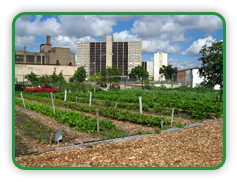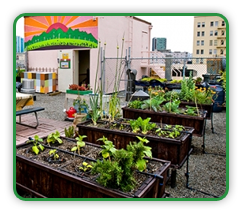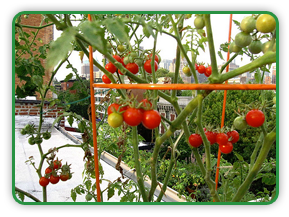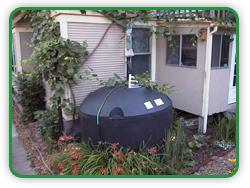|
Home > Guides > Urban Gardening > Urban Permaculture > Efficiency Gardening |
|
Efficiency Gardening |
Urban Permaculture  Efficiency Gardening Efficiency Gardening |
What is Permaculture? Permaculture, short for permanent and agriculture, and was coined by Bill Mollison and David Holmgren in the 1970s. Central to this idea is that agricultural design should be in accord with nature. Local conditions, including climate, topography, available water and other factors are all taken into account to implement novel and sometimes unconventional techniques to minimize energy input and maximize agricultural output of an efficiency garden.
|
 |
|
|
| |
|
|
| |
|
|
| |
Urban Permaculture
Sustainability
 Crops well-suited for apartment gardening are those with low to moderate light needs, minimal required soil-medium depth, and short time to harvest. Generally speaking, leafy greens or crops cultivated Crops well-suited for apartment gardening are those with low to moderate light needs, minimal required soil-medium depth, and short time to harvest. Generally speaking, leafy greens or crops cultivated
at a developmental stage prior to full maturity will make the best choices. Other types of edibles, including those cultivated for their root, fruit, or seed require significantly more energy and time, and are not ideal for limited space gardening. Popular leafy greens such as lettuce, arugula, kale and others have the added benefit of a shorter time to harvest, typically less than 2 months from seed to dinner plate.
 Permaculture in the Urban Setting Permaculture in the Urban Setting
While Permaculture has traditionally been applied in rural settings where time and space may be more plentiful, there is considerable room for these ideas in urban settings as city dwellers seek to optimize their surroundings for beauty and sustainability. Urban environments are often limited by several factors, chiefly space, soil, and light. A permaculture approach would seek ways to take advantage of these 'limitations' and make the best, most efficient use of available resources. Transforming vacant lots into community gardens, building greenhouses, composting organic waste to produce topsoil and making provident use of shade and light cycles from tall urban structures are just a few means to add vigor to urban environments with permaculture.
|
| |
|
|
|
| |
|
|
|
|
Gardening For Efficiency
 Growing food in limited spaces such as urban or suburban settings requires careful planning and prudent use of resources at hand: principally space, soil, light and time. Permaculture in an urban setting incorporates many of the same efficient techniques and philosophies that are practiced in a traditional agricultural environment. Succession planning can be utilized with many crops to ensure a continual supply of edibles throughout the season. Crop rotations should be undertaken regularly to provide relief from the strains that heavy feeders, such as tomatoes, can place upon the soil. Moreover, the gardener who practices permaculture develops a keen understanding of the assets and deficiencies of their specific growing space. They constantly look for ways to manifest greater efficiency, flow, and production while negating, or even transforming, supposed limitations. Growing food in limited spaces such as urban or suburban settings requires careful planning and prudent use of resources at hand: principally space, soil, light and time. Permaculture in an urban setting incorporates many of the same efficient techniques and philosophies that are practiced in a traditional agricultural environment. Succession planning can be utilized with many crops to ensure a continual supply of edibles throughout the season. Crop rotations should be undertaken regularly to provide relief from the strains that heavy feeders, such as tomatoes, can place upon the soil. Moreover, the gardener who practices permaculture develops a keen understanding of the assets and deficiencies of their specific growing space. They constantly look for ways to manifest greater efficiency, flow, and production while negating, or even transforming, supposed limitations.
Techniques for Gardening Efficiently
 Other techniques for gardening efficiently are centered around the conservation and proficient use of available resources, including water, soil and space. Rainwater collection requires significantly less energy than pumping ground water to the surface, and is of particular interest to gardeners in locations that see fluctuations in rainfall throughout the year. Soil can be conserved and amended through consistent and attentive composting and soil amendment. In conjunction with careful container gardening, or other farming methods to protect valuable topsoil, these practices can help to promote healthier, more nutrient-rich soil in future seasons. For more efficient gardening in confined spaces, vertical gardening with trellis, shelves, or other supports can help to promote upward growth and maximize available light. Other techniques for gardening efficiently are centered around the conservation and proficient use of available resources, including water, soil and space. Rainwater collection requires significantly less energy than pumping ground water to the surface, and is of particular interest to gardeners in locations that see fluctuations in rainfall throughout the year. Soil can be conserved and amended through consistent and attentive composting and soil amendment. In conjunction with careful container gardening, or other farming methods to protect valuable topsoil, these practices can help to promote healthier, more nutrient-rich soil in future seasons. For more efficient gardening in confined spaces, vertical gardening with trellis, shelves, or other supports can help to promote upward growth and maximize available light.
|
|